When I (re)started my interest for Simmons drums back in 2003, I immediately found a white and shiny 5 piece SDSV kit on Ebay, located in Switzerland. Although I did not win the auction, I was not too disappointed as Simmons drums regularly appeared there from time to time. Since then I daily check Simmons offers on Ebay in several key areas such as US, UK and of course Germany as well as several websites providing small adds and I must say that the offers became less and less over the years, those ones that I found are mostly very expensive and/or in poor condition. So sometimes I think that I started to collect at a better period of time. Those of you who are still desperately waiting for an SDSV or SDX need much more patience and … money. One more reason to keep the remaining gear and all the docs and gossip alive. Simmons, an endangered species…
endangered species
January 29th, 2010Live Aid I985
January 22nd, 2010Normally I forget events really quick. But there are some I still remember what I actually did during that event. I remember the day of the great Live Aid concert. Unfortunately I spent the whole day in a train to London and I could not follow the show on TV. So many bands used Simmons drums at least to spice up their drum or percussion set up and I couldn’t watch their performances… Really disappointing. Fortunately we have the internet and some deligant guys who published at least parts of these historical pop events such as (just to mention a few)
David Bowie feat. Thomas Dolby on keyboards
Queen
Paul Young
Spandau Ballet (with John Keeble who obviously used his only remaining SDSV pad as a place for his metronome :-))
The Cars
Simmons alive and kicking – Polytune
January 2nd, 2010Yes, there are still bands around using Simmons on recordings and … live on stage! Here’s one: Polytune from Germany. Drummer Fake still trusts in his scuffproof black SDSV:
Merry Christmas!
December 24th, 2009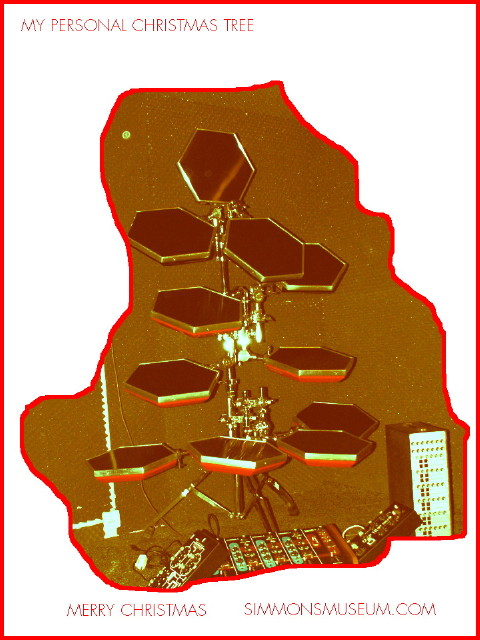
my end-of-the year review
December 21st, 2009When I launched simmonsmuseum.com in 2003, my intention was nothing more than sharing some pics and documentation and to use this site to check out web technologies. I neither expected much interest for my site nor for myself. The year 2009 once again proved me wrong and gave me many hexagonal highlights. My collection increased by two analog claptraps: One Musicaid and one Simmons (not documented yet, shame on me…). I picked up my fifth SDSV. A real bargain with a set of pure white pads in fabulous condition. My collection of catalogs grew: The total size of download files on simmonsmuseum.com passed the 1 GB borderline so I was forced to extend my webspace from 1 GB to 10 GB.
I initiated my Youtube channel. Again more or less to experiment with technology. The first video was published on May 17th. Up to now I published 9 videos on this channel in order to provide demos of my gear. Already viewed by more than 10000 visitors so far.
In Summer I visited Michael Buchner and wrote a report about his passion for electronics and research on electronic drums. There I also got to know Oli Rubow, probably the most famous drummer in electronic music in Germany.
In October, I started my own wordpress blog. I discovered my passion for writing since I had the pleasure to write and publish a report about Simmons drums in Germany’s drummer magazine “Sticks”.
Since I optmized my Google ranking, simmonsmuseum.com has none less than 1800 visitors (1100 unique vistore) per month (source: Google Analytics) which is a lot for a private non commercial website. My guestbook had 71 entries in 2009 which is also an indicator for a vital website. Thanks for that!
What will 2010 bring?
I have so many plans…. If I can realize only 10%, I’ll be glad! 2010 will hopefully bring a stunner which I will write about as soon as it is certain. I am very excited…
I want to thank all visitors and supporters of my site and blog. I really feel honored by every feedback I get. I am confident that 2010 will be as cool as 2009, even better…
Hexagonal Christmas and a hexagonal new year!
Did Simmons reveal it's own sound?
December 14th, 2009As we all should know in the meantime, the SDSV rung in the age of electronic drums. The analog sound was a result of the technical stage at that time. And of course the way Dave Simmons developped his circuits (malicious gossip has it that ARP and Moog also considerably “influenced” Dave…) brought a random aspect in that what was later called “the Simmons sound”. But from that milestone on, every generation of Simmons drums increased the distance to that point of origin. How is that? The SDSV was released in a time when the digital sound generation already forged ahead. The Simmons company had a great product, but also a great portion of luck that they could sell it in a reasonable number. The SDSV HiHat and Cymbal modules had even already been based on samples. The analog sound was a period of temporary fashion. Every music epoch (since mankind is playing/singing music) requires it’s own sound and also drops the sound sources when the time is right for a change. If Simmons wanted to survive as a business company, they had to listen to the requirements of musicians and react. If Volkswagen would still offer the Beatle as their only car, the company would definetely not exist anymore.
If you follow the timeline it is obvious that the analog parts had been substituted by digital:
- 1981: SDSV (fully analog)
- 1984: SDS7 (all channles hybrid analog and digital)
- 1985: SDS9 (digital bassdrum and snare, analog toms)
- 1986: SDS1000 (digital bassdrum and snare, analog toms)
- 1987: SDX, SDS2000 (fully digital)
So the whole development was a matter of fashion and competion. If Simmons would have kept building analog drums only, they would have smashed much earlier. Still they embedded Simmons sounds. For example there were several SDSV libraries available for the SDX, the SDS2000 had a bunch of sampled analog sounds on board.
The answer is: no
Vintage meets modern
November 27th, 2009Since I deal with electronic drums, I search for the perfect electronic drum set. For sure Simmons never built the perfect drum kit, especially not from today’s point of view. But what is the perfect drum kit? First of all it should be unique and full of character. This at least fits to the look of the SDSV pads, in my opinion the sexiest pads ever designed. Unfortunately the stick impact is absolutely out of the question concerning both noise and playability. And the dynamics cannot keep up with todays high tech pads made by Roland, Hart, Yamaha etc… On the other hand today’s pads look rather boring. They try to imitate real acustic drums what I think is the wrong way. So why not take the best aspects of both worlds and join them into generation of pads which look great and don’t hide that they are electronic but with great playability and dynamics? When I planned this project I already owned enough SDSV pads to built a prototype kit at a reasonable budget. In the meantime I was asked a couple of times to report about this. So here you are:
The ingredients for one drum:

- 10″ tom (foil, not lacquered). The cheapest you can get will do it. Mine cost 29 Euro
- 1 transducer (Ebay: 2 Euro)
- 6 tap boots M5 (DIY store: 2 Euro)
- 10″ Mesh head (double layer: 20 Euro)
- 1 self-adhesive felt pad (those you would use to keep the doorhandle from a wall. DIY store: 2 Euro)
- 1 6.3mm mono jack
- 1 SDSV pad
Tools:
- tuning key
- several screwdrivers
- fine saw
- drill (8mm driller)
- hammer
First I ripped all hardware and foil off the tom:

Than I cutted a 4cm ring from the top and the bottom side (as you can imagine we can convert two pads from only one tom). To estimate the right thickness I layed the drum head and rim onto the drum for line-marking.

Than we can go on dismantling the SDSV pad and place the tap boots, transducer and the jack:

Now it’s time to assemble the pad again:

Then I simply put the ring on the riot shield and fill it with rubber foam. I sticked the felt on the transducer in order to protect it against
direct hits and to dampen the trigger pulses. The transducer does not need to be fixed. This is simply done by the pressure of rubber foam, felt and mesh head

Last but not least I mounted the head and “tuned” the drum. That’s it

And the entire kit:
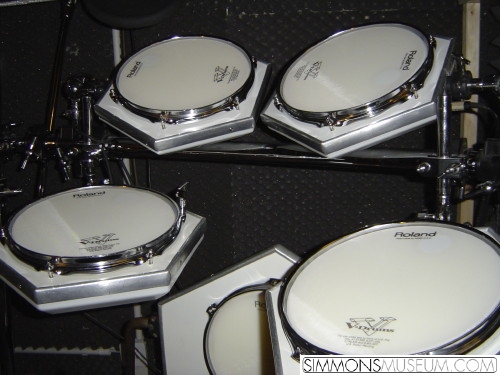
The dynamics are really great although the components did not cost much more than 30 Euro per pad. Of course this project can be realized with any wooden subsurface. So what about converting your desktop into a mesh pad?
And that’s the kit in action:
The sounds are from Toontrack Superior 2. Pretty close to perfect….
Simmons HiHat Controllers
November 20th, 2009Have you ever looked inside a common HiHat controller? The technology inside is just as simple as expected: If you step onto the pedal, a curcuit is being closed and the inner resistance is immediately set from infinite to zero. So the drum brain only needs to messure the remaining current in order to decide whether an open or closed HiHat sound is supposed to be played back. Modern controllers which can even map half open states probaly provide a variable conductance between open and closed, more or less linearly depending on the angle of the plate. And Simmons? Please correct me, but I suppose the SDSV HiHat pedal was the first of its kind. So it should be justified that Dave Simmons is the inventor of it. But it was differnt. It was based on a light barrier. The source of light was permanently powerd by the brain (15V). When the pedal was closed, a metal tongue interrupted the beam of light, the sellenium cell opposite to the source could not send anymore current to the brain which triggered the “decay killer” (this expression comes from the SDS3).
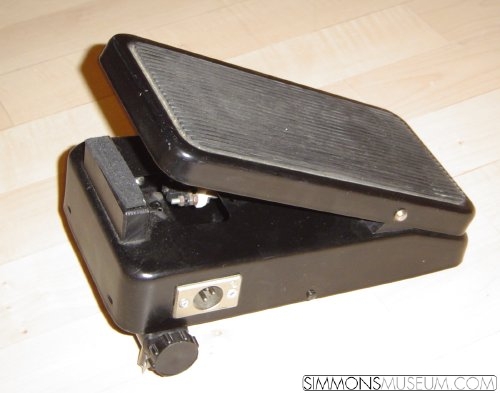
By the way: Always keep in mind that if you connect a HiHat controller other than the original to an SDSV brain: You might damage your pedal!
But Dave Simmons not only invented the open/close Hihat pedal. One of the trailblazing innovations of the SDX was that the first time an electronic HiHat provided more than open/closed/closing but also half open. This was realized by pessure. The pedal had the same FSR foil built in as the pads did have. Depending on how strong you kicked the pedal down the inner resistance could be modulated.
Rock School
November 15th, 2009On my endless odyssey through the internet once more I tumbled over an episode of Rock School, and once more I wondered about the cheesy sounds that had been so hot in the 80s.
Today it makes me smile but of course every era of pop music requires it’s predecessors. For example dance and electronic music would not sound the same if the technical development would have taken another way. The 80s had created highlights as well as catastrophes concerning sound (this may appear to style and clothes as well…). I wonder what my kids will think about a Roland TD20 in 15 years (to be honest: I already think they are antiquated and a deception of high technology, but this should be discussed in other blogs)
In any case: Have fun watching this nice peace of TV history!
Simmons and the plagiarisms II
November 15th, 2009A couple of posts ago I reported about polish copies of Mark III pads. This time I “found” a pair of russian copies made by a company called LELL:
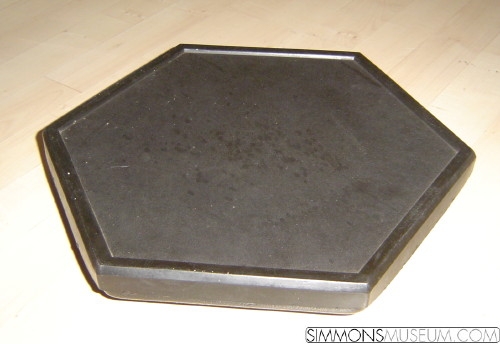
The playing surface is very much like Mark III type
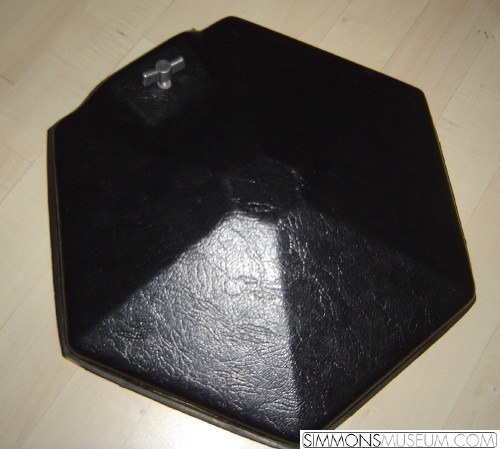
The surface of the backside has an imitation leather stamping
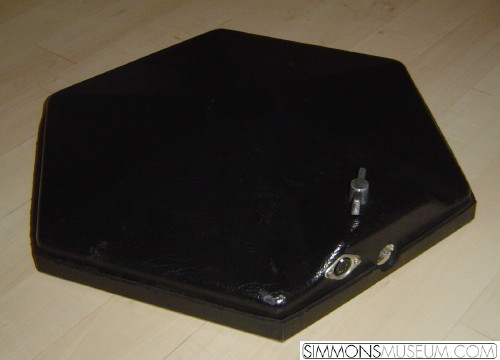
the tom mount is not Pearl compatible but is similar to the first generation of Dynacord Percuter Pads. The connection is a midi socket
It’s funny to imagine how Simmons fought against those copies coming from western countries while beyond the iron fence the eastern countries unobservedly copied everything. But as I know from my Simmons buddy from eastern Germany: During the cold war a Simmons was a Simmons and everything else was a copy.
